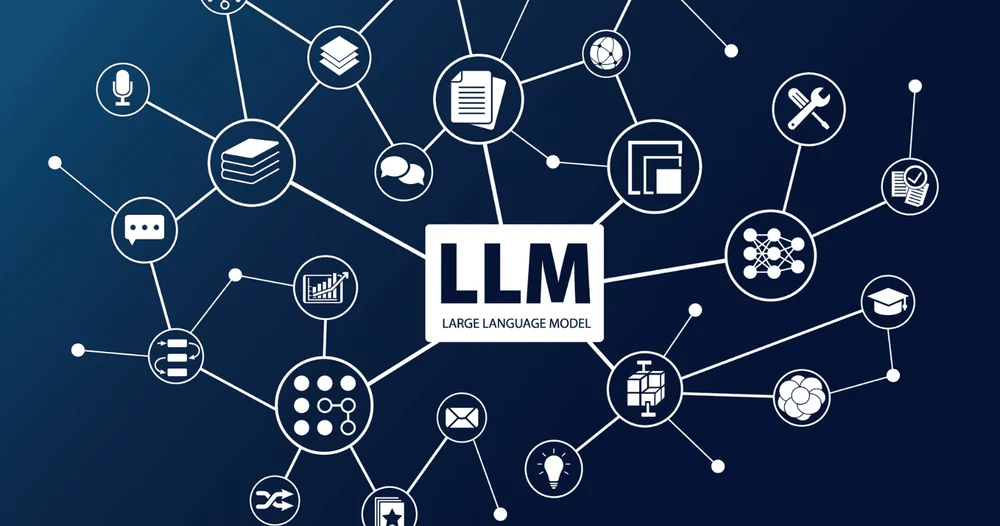The Emergence of Private Large Language Models in the Life Sciences Industry: Revolutionizing Generative AI

by Brian Fitzgerald | Last Updated: October 24, 2023 | 1 min read
In the ever-evolving landscape of technology, Generative AI, Machine Learning (ML), and Artificial Intelligence (AI) are pivotal forces reshaping industries and revolutionizing the way we interact with data. Large Language Models (LLMs) stand at the forefront of this transformation, making their mark as powerful engines of innovation. However, with great power comes great responsibility, and the privacy and security implications of public large language models have led to the emergence of private LLMs, a trend particularly pronounced in the life sciences industry.
Large Language Models (LLMs) stand as beacons of innovation and transformation in this current landscape. Advanced algorithms, using AI and ML, are changing how people interact with computers by rewriting the rules.
Exploring the Impact of Large Language Models (LLMs) on Various Industries
LLMs have ushered in a new era of business operations. They assist in content generation, automate customer interactions, and provide data-driven insights, enhancing efficiency across various industries. The life sciences sector has embraced LLMs for their potential to accelerate research and improve healthcare. However, this adoption comes with unique challenges.
Challenges in the Life Sciences Industry
Life sciences, with their complex research and sensitive patient data, face distinct challenges. The integration of LLMs requires careful consideration. Privacy and security take center stage in the life sciences industry. Large Language Model deployment requires us to protect patient data, making data privacy and security a critical aspect.
The significance of LLMs extends far beyond their technical capabilities. They are shaping industries, enhancing operations, and promising groundbreaking advancements in healthcare. However, as they continue to evolve, addressing the unique challenges and security concerns of the life sciences sector is essential to ensure their responsible and beneficial usage.
Private Large Language Models vs. Public Large Language Models: A Crucial Distinction
This distinction between private and public Large Language Models is pivotal. It hinges on their data sources and plays a critical role in data privacy and the emergence of Artificial Intelligence hallucination risks. Private Large Language Models LLMs stand as guardians of data privacy, creating a secure environment within the organization. Private Large Language Models LLMs exclusively use in-house data, ensuring the confidentiality of sensitive information such as patient records, research findings, and proprietary business data. The "need-to-know" principle is upheld, granting access only to authorized personnel, and preventing unauthorized breaches.
The “Walled Garden” Approach to data protection provides a protective boundary for the LLM to operate within which is fortified by stringent security measures, keeping data safely ensconced. Robust encryption is employed to shield data from unauthorized access during storage and transit.
Data security breaches in life sciences can be catastrophic. Patient privacy, sensitive research findings, and intellectual property are at stake, underscoring the importance of private Large Language Model.
Explore More Relevant Articles on P360
- Top Data Management Best Practices for Businesses
- Pharma Marketing Unveiled: Strategies for Success and Compliance in the Digital Age
- Powering Master Data Management Success with Data Analytics
- Digital Marketing in Pharma: Key to Enhancing Sales and Strategy
- Embracing CRM Agnosticism: A Key Strategy for Pharma Innovation
Artificial Intelligence Hallucination and Its Implications
Artificial Intelligence hallucination is a perilous phenomenon where Large Language Model generates content that is seemingly accurate but is factually incorrect or misleading. They occur when a language model generates content that sounds plausible but contains inaccuracies. This poses serious concerns, especially in sectors where accuracy is paramount.
In healthcare, Artificial Intelligence hallucinations can have life-threatening consequences. For example, if a healthcare chatbot offers erroneous medical advice or misinterprets symptoms, patient safety is at risk.
Incidents of Artificial Intelligence hallucination in real life serve as stark reminders of the risks associated with public Large Language Models. These incidents highlight the need for data privacy and the cautious use of generative AI models in sectors where factual accuracy is non-negotiable.
Deploying Private Large Language Models (LLM): A Strategic Challenge

Private Large Language Models (LLMs) represent a potent tool for leveraging the capabilities of Generative AI, Machine Learning, and Artificial Intelligence within an organization. They hold the key to enhancing content creation, automating customer interactions, and unlocking valuable insights from unstructured data. However, the strategic challenge lies in effectively deploying these private Large Language Models to reap their benefits.
Building Custom Private Large Language Models (LLM)
Private Large Language Models (LLM) are custom-made and used strategically to utilize the power of generative AI in organizations. However, the deployment of on-premises large language models comes with its own set of advantages and disadvantages.
Building a custom private Large Language Model allows companies to tailor the model to their specific needs, ensuring it aligns perfectly with their objectives. Companies have complete control over the data used to train the model, enhancing data security and privacy. And developing a custom private Large Language Model demands substantial financial investment and resources. The process of data mining which includes collecting, cleaning, and sorting of data is time-consuming and requires expertise. In-house Large Language Model development necessitates a team of experts in Machine Learning, AI, and Natural Language Processing, which can be a significant challenge to assemble.
Using APIs for Private Large Language Model Development
An alternative to building custom private Large Language Model (LLMs) is utilizing APIs (Application Programming Interfaces) provided by Large Language Models (LLM) service providers. This approach offers its own set of advantages and concerns.
API Utilization is very convenient for companies because they offer a quick and convenient way to integrate private Large Language Model (LLMs) into existing systems and applications, saving time. Also, using APIs requires less in-house expertise, as the service provider manages the underlying technology.
Risks and Concerns in API Deployment
Data Privacy: When relying on third-party APIs, companies must entrust their data to external providers, potentially raising privacy concerns. This is why the need for oversight and redundancy is important for the security of a company’s information.
Scalability Limitations: The functionality of an such API is predefined, which limits the extent to which it can be customized to meet specific functional requirements.
Ensuring Data Security When Using Third-party APIs
To overcome the security challenges of using third-party APIs for private LLM deployment, organizations need to take certain precautions such as data encryption. Employing strong encryption methods to protect data during transit and storage. Companies should also employ data handling policies to govern how the service provider handles data and ensure compliance with privacy regulations. Additionally, conducting periodic security audits and assessments to monitor the service provider's data handling practices.
The Risks of API Utilization for Private Large Language Model (LLM) Development

In the quest for cost-effective solutions, some organizations opt for APIs to develop their private Large Language Models (LLMs). While this approach may lead to cost savings, it introduces a set of higher risks, especially concerning data breaches. Using APIs means entrusting your data to a third party, potentially compromising sensitive information, including valuable intellectual property.
Protecting Intellectual Property in API Usage
Intellectual property (IP) stands as a priceless asset for many organizations. This includes patents, copyrights, trademarks, and trade secrets that drive innovation and competitiveness in the organization. When using APIs for private Large Language Models (LLMs), safeguarding this intellectual property becomes a paramount concern.
Intellectual property is the lifeblood of innovation. It represents the unique ideas and creations that set a company apart in the market. Also safeguarding IP ensures that competitors cannot replicate an organization's proprietary technology or content.
Risks of Data Leakage and Intellectual Property Compromise
Data Exposure: Using third-party APIs can make your private information vulnerable to possible security problems. This can result in people getting into your systems without permission or stealing your data.
Reverse Engineering: Sometimes, the code and data used by the people who make the API can be easy to figure out in a backward way. This can be a problem because it could expose a company's special ways of doing things and its important information to others.
Strategies for Safeguarding IP in API-driven Large Language Models (LLM)
To mitigate the risks to intellectual property when using APIs for private Large Language Model LLM development, organizations can employ several strategies:
Ensuring Data Consistency and Accuracy in API-driven Large Language Models (LLMs)
When relying on third-party APIs, maintaining data consistency and accuracy is vital to ensure the reliability of the Language Model. Companies will want to implement rigorous data validation and preprocessing procedures to ensure that input and output data meet high-quality standards. They will also want to clearly define data ownership and responsibilities to prevent disputes and ensure the consistency of data handling.
For the best results, businesses need to continuously monitor data input and output for discrepancies or inconsistencies, allowing for rapid correction and establish clear data integration protocols to maintain data consistency and accuracy throughout the API-driven LLM's lifecycle.
Conducting regular checks of the API provider's methods and tools to make sure they handle data well and keep it safe should be a standard of practice. Additionally, implementing robust encryption protocols to protect data during transit and storage will reduce the risk of data breaches.
Customized Solutions: Striking the Right Balance
In the changing field of life sciences, where using Language Models is very important, there's a new way that's becoming a good solution. Custom solutions help with the problems that come with using APIs and the hard work of making your own big Language Models. These solutions help life sciences companies deal with their unique challenges and use Language Models to reach their business goals. Customized Large Language Mode solutions play a multifaceted role in addressing the diverse needs of life sciences organizations:
1. Tailoring Large Language Models (LLM) to Unique Business Objectives: Customized Large Language Models (LLM) offer the flexibility to align with precise business objectives, enabling organizations to achieve their goals more effectively.
2. Enhancing Clinical Trial Data Analysis: In the realm of clinical trials, custom Large Language Models (LLM) can expedite data analysis, assisting in the identification of crucial patterns and insights.
3. Improving Sales and Customer Interactions: Custom Large Language Models (LLM) can be harnessed to personalize customer interactions, enhancing sales processes and customer satisfaction.
4. Analyzing Patient Sentiment and Social Media Data: These customized solutions provide the ability to analyze patient sentiment and social media data, offering valuable insights for decision-making.
5. Regulatory Compliance and Customized Large Language Models (LLM): Customized LLMs are adaptable to meet the specific regulatory and compliance requirements of the life sciences sector, ensuring adherence to ethical and legal AI usage.
6. Meeting Regulatory and Compliance Requirements: Custom Large Language Models (LLM) can be configured to align with the intricate regulatory and compliance demands of the life sciences industry.
7. Ensuring Ethical and Legal AI Usage in Life Sciences: Customized solutions emphasize ethical and legal AI usage, providing organizations with confidence in their AI-driven processes.
8. The Importance of Adherence to Quality Standards: These solutions uphold the highest quality standards, ensuring that the applications of Large Language Models (LLM) in life sciences meet the necessary benchmarks.
The Future of Private Large Language Model Large Language Models (LLM) in the Life Sciences Industry
As we look ahead in the field of life sciences, big computer programs like Large Language Models are going to change a lot. This change will happen because of fast-moving technology like Generative AI, Machine Learning, and Artificial Intelligence.
Innovations in private LLMs promise to accelerate drug discovery, enhance clinical trial data analysis, and improve patient care. These models will adapt to the evolving needs of life sciences companies, catering to unique business objectives.
Ethical considerations surrounding LLM deployment will continue to be at the forefront. Maintaining patient data privacy and adhering to regulatory compliance remain paramount in the ethical use of LLMs in healthcare.
The Ongoing Evolution of Generative AI in Healthcare
Generative AI in healthcare is getting better and better. It's going to change how doctors diagnose patients, create new medicines, and make medical information. Private AI systems will be important for using AI's power in healthcare while making sure we do things the right way in the medical field.
Private Large Language Models (LLMs) are rapidly gaining ground in the life sciences industry, offering a secure alternative to public LLMs while mitigating the risks of AI hallucination. Deploying these private LLMs presents organizations with several choices, each with its own set of advantages and risks. While APIs offer cost savings and custom LLMs provide tailored solutions, customized LLMs strike a balance, offering the benefits of customization while minimizing potential risks. As the life sciences industry continues to embrace the power of AI, choosing the right path for private LLM deployment will be a critical decision for companies seeking to protect sensitive data while leveraging the capabilities of Large Language Models (LLMs) to drive innovation and efficiency.